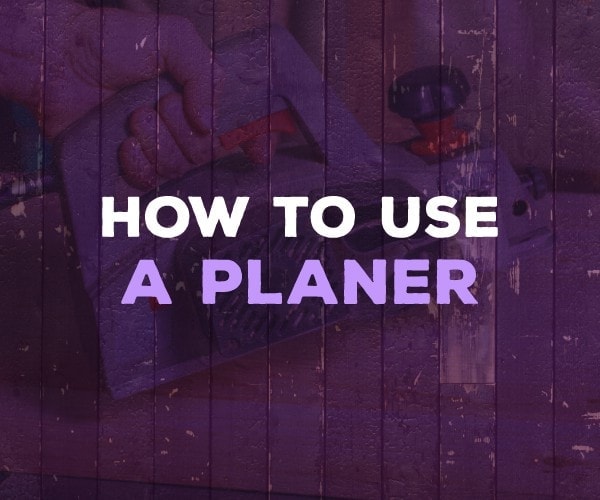A planer is a woodworking tool that’s used to mill lumber. It helps you smooth rough edges, shave wood to your desired thickness, and flatten warped boards.
Though it’s not absolutely vital for your DIY woodworking shop, a benchtop planer will certainly make most DIY woodworking projects that much easier.
Luckily, it only takes a few minutes, even for beginners, to learn how to use these devices to safely and efficiently plane a piece of wood.
Here’s how to use a planer for your next project.
What You’ll Need
You don’t need much to effectively operate a planer.
Here’s what you need:
- Benchtop Planer (Our Top 5 Reviewed)
- Sturdy Work Table
Because a planer is a power tool that throws up a considerable amount of sawdust and wood chips, it’s important to wear the proper safety equipment.
Recommended safety equipment includes:
- Hearing Protection
- Eye Protection
- Safety Gloves
Step I: Prepare Your Planer
There’s a little bit of setup required before you start to use your planer.
The first step is to make sure that the blade area is free of debris. Sawdust and wood chips often stack up here, so it’s essential to remove them before starting in on a new piece of wood.
You should also set the planer blade to the rough height of the first board you wish to plane.
The key is to plane off small amounts of the board at a time. Especially when you’re planning multiple boards that will go together (such as for trim), you want to make sure you don’t take off more than you need.
Inspect each board after preparing your planer. Make sure there are absolutely no nails, screws, or any other objects that could damage the machine.
Step II: Plane Flat Side
Run each board through the planer lengthwise.
Start by running them through with the planer running over the flat, wide side of each board.
Like I mentioned above, gradually adjust the planer, planning off a little more each time, rather than trying to take off large amounts at once.
Instead of planning one board at a time, I prefer to plane them all together if they need to all be milled to the same thickness.
For example, I’ll run each board through with the planer set to one height. Then I’ll adjust the planer down to peel off more wood and run the boards through again. I repeat this process until the boards are flat and at my desired thickness.
Remember to plane both sides of each board for the smoothest and flattest finish possible.
Step III: Clean Up Edges
Now that you’ve finished planning the flat side of each board, it’s time to clean up the edges.
This is where you run each board through the planer on its side so that the narrow edge is smoothed and flattened.
If you’re planning several boards at once that all need to be the same size, I recommend running several of them through the planer at once.
You can typically safely run three to five boards on their edges through a planer at the same time.
Remember to plane both sides of each board’s edges for a smooth finished product.
Avoid Common Mistakes
Perhaps the most common mistake beginners (and even experts) make when using a planer is a tearout.
A tearout occurs when you feed a board into a planer with the wrong side of the grain going into the planer first.
If you put a board into a planer with the rough side forward, there’s a good chance that the planer will catch the grain. This causes gauging and cuts in the wood.
Always inspect each piece of wood before feeding it into a planer to make sure that the smooth edge enters the machine first.
What About a Hand Planer?
Today’s guide details how to use a benchtop planer.
But another common type of planer is a hand planer. As the name describes, this is simply a smaller, handheld version of the tool.
Hand planers accomplish much the same task as a benchtop planer, except at a smaller scale.
The catch is that they’re more for smoothing and flattening pieces of wood, rather than milling them all to the same thickness and width.
Because the tools are handheld and require pressure from you to cut, they aren’t nearly as accurate at cutting an entire board to the same thickness as a benchtop planer.
That said, they’re still a very effective power tool for many uses, especially when you need to plane a board that’s already been installed or nailed up.
Final Thoughts
A planer is another woodworking tool that any DIY woodworker needs to know how to use.
Fortunately, learning how to use a planer is easy, even for complete newbies. All it takes is an understanding of the basics and enough time to experiment until you feel comfortable.

